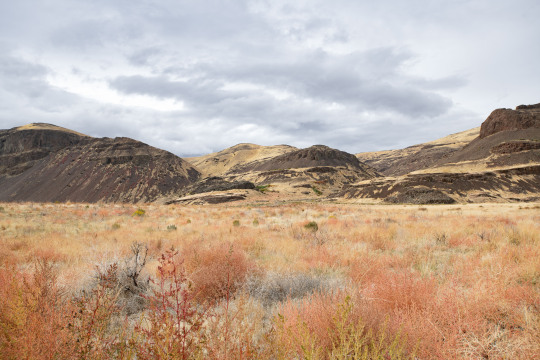Text

This floating alien egg is Octameroceras, they're part of a group of cephalopods called Oncocerids which diverged earlier than the nautiloids and ammonites.
As they reach maturity, their shell opening, the aperture closes in on their face creating these Giger-esque shapes, and we can only speculate what bizarre mangled forms the creature peeping through that opening would have.

[image credit: Stridsberg, S. 1 985 05 09: Silurian oncocerid cephalopods from Gotland. Fossils and Strata, N o. 1 8, pp. 1-65. Oslo ISSN 0300- 9491. ISBN 82- 00- 07575-3.]
2K notes
·
View notes
Text

A mountain lion cub feasting on a mountain goat carcass. Photographed by Stay Wild Media.
5K notes
·
View notes
Text
My Bird Feeder live stream is... well... LIVE! Well publicly live now I mean. I have been wanting to do something like this for years. I finally got things set up and have a stable enough internet I think it will work. Come watch birds with me!
29 notes
·
View notes
Text

The Galápagos penguin is endemic to the Galápagos Islands and is the rarest penguin. Because they can't breed when ocean surface temperatures are above 25C, they're especially affected by climate change. Ecotourism is also a threat, due to littering and irresponsible birdwatching.
789 notes
·
View notes
Text
The first of several red wolf pairs was recently released into the wild by USFW, and the Facebook comments on the official announcement are of course filled with uneducated hunters and self-proclaimed “wildlife biologists” labeling them “vermin,” “coyotes,” or “not real wolves,” and openely promising to shoot or trap them to “protect” the deer and turkeys. The red wolf project is incredibly personal to me, and it’s absolutely nauseating to see cruel, selfish humans threaten the lives of animals I know and have cared for.
Red wolves (Canis rufus) are native to the southeastern United States. We have fossil evidence dating them back at least 10,000 years. Recent DNA evidence (2021) suggests their presence in North America may predate even gray wolves and coyotes, making it impossible for the species to be simply wolf-coyote hybrids as was once widely believed. The American Society of Mammology recognizes them as a distinct species, and they are protected under the Endangered Species Act.
Red wolves are a separate, unique species. Red wolves are part of the natural ecosystem of the southeastern United States, and they have been here long before European colonists ever arrived. Red wolves belong on their ancestral land. They are considered critically endangered by the IUCN Red List, and killing one carries grave legal consequences under federal law. Conservation is about maintaining a healthy planet of both predators and prey, not preserving overpopulations of game species so there’s plenty to go around for recreational hunters.
Save the American red wolf.
4K notes
·
View notes
Text
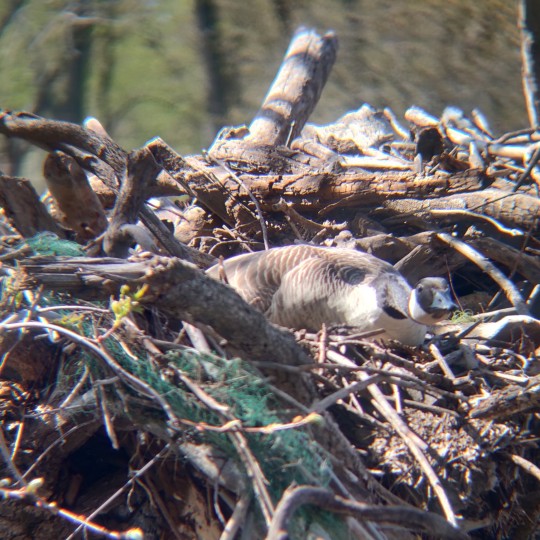
This lady was watching me and my friend very intently as we walked past her nest
#canada goose#goose#geese#canadian geese#birds#bird nest#mine#ornithology#nature#wildlife#naturalist#nature photography#photography#ecology#north america#animals#bird watching#birding#bird photography#birdwatching#bird#ecologist#biology#wildlife biology#biologist#original photography#original photographers#wildlife photography
23 notes
·
View notes
Text

Lots of fresh beaver chews by the river today! 4/24/24
#beavers#animal tracking#nature#wildlife#beaver#mammals#mine#naturalist#nature photography#photography#ecology#north america#animals#original photography#original photographers#landscape photography#landscape#native land#river#rivers#ecologist#biologist#natural history#environmental education#forest#trees
19 notes
·
View notes
Photo

Early Humans sheltered in this lava tube 10,000 years ago—and it’s still in use today
Fossils and stone tools show that a cave in Saudi Arabia has been used as shelter by humans for millennia, up to the present day.
https://www.scientificamerican.com/article/early-humans-sheltered-in-this-lava-tube-10-000-years-ago-and-its-still-in/
22 notes
·
View notes
Text
it is once again... binturong appreciation hour
19K notes
·
View notes
Text

Goniurella tridens is a species of fruit flies that carries on each wing the perfect image of an ant
1K notes
·
View notes
Text
"In a historic “first-of-its-kind” agreement the government of British Colombia has acknowledged the aboriginal ownership of 200 islands off the west coast of Canada.
The owners are the Haida nation, and rather than the Canadian government giving something to a First Nation, the agreement admits that the “Xhaaidlagha Gwaayaai” or the “islands at the end of world,” always belonged to them, a subtle yet powerful difference in the wording of First Nations negotiating.
BC Premier David Eby called the treaty “long overdue” and once signed, will clear the way for half a million hectares (1.3 million acres) of land to be managed by the Haida.
Postal service, shipping lanes, school and community services, private property rights, and local government jurisdiction, will all be unaffected by the agreement, which will essentially outline that the Haida decide what to do with the 200 or so islands and islets.
“We could be facing each other in a courtroom, we could have been fighting each other for years and years, but we chose a different path,” said Minister of Indigenous Relations of BC, Murray Rankin at the signing ceremony, who added that it took creativity and courage to “create a better world for our children.”
Indeed, making the agreement outside the courts of the formal treaty process reflects a vastly different way of negotiating than has been the norm for Canada.
“This agreement won’t only raise all boats here on Haida Gwaii – increase opportunity and prosperity for the Haida people and for the whole community and for the whole province – but it will also be an example and another way for nations – not just in British Columbia, but right across Canada – to have their title recognized,” said Eby.
In other words, by deciding this outside court, Eby and the province of BC hope to set a new standard for how such land title agreements are struck."
-via Good News Network, April 18, 2024
13K notes
·
View notes
Text

African bush elephant Loxodonta africana
Observed by nancylightfoot, CC BY-NC
93 notes
·
View notes
Text

A young lion looks toward the Nairobi skyline from Nairobi National Park in 2015. Photographed by Tony Karumba.
673 notes
·
View notes
Text
Wet Beast Wednesday: pistol shrimp
Oh snap, it's the snapping shrimp post for Wet Beast Wednesday! Snapping shrimp or pistol shrimp are loud little critters that have evolves a very useful and fascinating tool in their pincers. Let's not waste time and shoot off to learn about these little gunslingers.
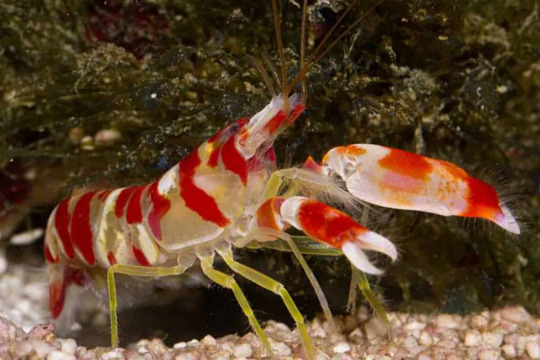
(Image: a pistol shrimp. It is a mostly white shrimp with red stripes. One of its claws is considerably larger than the other. It is standing on gravel and next to some seaweed. End ID)
Pistol shrimp are over 1,000 members of the family Alpheidae, which is part of the infraorder Caridea. This means they are true shrimp, not to be confused with superficially similar animals like brine shrimp, mantis shrimp, tadpole shrimp, and prawns. Yeah, I only recently learned that prawns and shrimp aren't a language difference between British English and American English like chips vs fries. They're not even that closely related. As true shrimp, pistol shrimp have two main body parts: the cephalothorax and abdomen, which are composed of 19 body segments. The abdomen forms a flexible tail with a fin on the end. When startled, the fin can rapidly curl under the body, propelling the shrimp backwards. Like other decapods, there are 10 limbs. The front pair of limbs have evolved into claws used to manipulate objects. The claws are the most distinguishing feature of pistol shrimp. They are asymmetrical, with one growing extremely large, over half the size of the body. The big claw has a modified version of the typical pincer. This pincer has an upper claw that can open up at a right angle. Under the claw is a pocket in the lower pincer, into which water flows. The upper pincer then slams down into this pocket, forcing the water out. The pressure of the pincer closing water in the pocket creates a cavitation bubble that is forced away from the claw at up to 26.8 meters per second. This is enough force to seriously wound small animals and hurt larger ones into leaving the shrimp alone. The cavitation bubbles can reach up to 4,427 degrees C (8,000 F) . For comparison, the surface of the sun is about 1,000 decrees (C) hotter. When the bubble pops, it creates a snapping sound that can reach 218 decibels. For comparison, most gunshots max out at around 170 db. This puts pistol shrimp is the running for the loudest ocean animals, with whales being the other main competitors. If that all sounds like a lot, the whole event happens so fast that the heat doesn't have time to affect much and the noise sounds like a moderately loud snap to us. Adults can snap their claws shut with an acceleration of up to 30 meters per second squared and juveniles can do it up to 20 times faster. The whole process takes less than a millisecond. When the cavitation bubble collapses, it can produce light. This is called sonoluminescence and nobody knows how it happens. If a pistol shrimp loses its large claw, the small claw will grow into a new large one while the missing limb will regenerate into a small claw. Adult pistol shrimp average between 3 and 5 cm long.
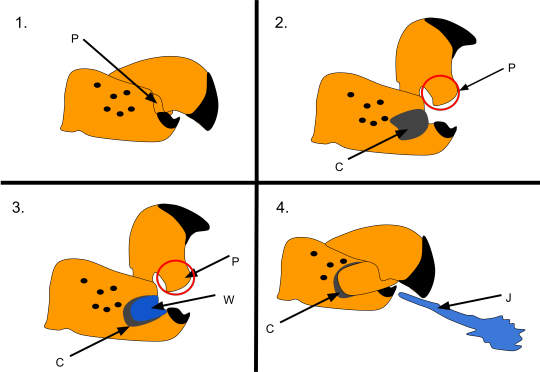
(Image: a drawing showing the process of a pistol shrimp snapping its claw. In the first panel, the claw is closed. In the second, the upper claw opens at a 90 degree angle, revealing a cavity. In the third panel, the cavity fills with water. In the final panel, the claw is closed again and a jet of water is ejected from the claw. End ID. Source: Wikipedia user Carermyers)
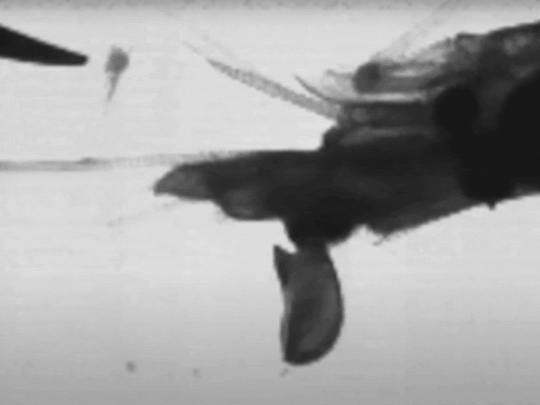
(Gif: black and white, slow-motion video of a pistol shrimp's claw snapping shut and creating a cavitation bubble. End ID. Source)
Pistol shrimp live worldwide, though most species live in tropical or temperate water. There are some cold water species and even freshwater species. Most prefer habitats where they can make burrows and where there are plenty of other animals. Coral reefs, oyster reefs, seagrass beds, mangrove groves are common habitats. Snapping is used for hunting and communication. They typically hide in burrows, waiting for fish or other small animals to pass by. When prey passes, the shrimp will snap to stun or seriously wound the prey, then drag it into the burrow. Some social species actually form eusocial hives with a single queen who produces all offspring. These shrimp are the only known marine eusocial species and all occur within the same genus (Synalpheus), though not every member of that genus is eusocial and eusociality appears to have evolved at least 3 times within that genus. It appears that a reason why only this genus developed eusociality is their larvae do not disperse, instead staying in the same area as the parents. The hives are usually located within sponges. Other social species are not eusocial, but still live together in colonies. Many less social species have formed a symbiotic relationship with gobies. Both species live in burrows, but gobies are bad at digging while the shrimp have poor eyesight. The goby will protect the shrimp while it digs a burrow, then the two live together. They will forage together, with the goby using its superior eyesight to watch for predators and warn the shrimp to get back to the burrow. Pistol shrimp are monogamous, the same pair coming back to mate over and over again (this does not apply to the eusocial species in which only the colony's queen is permitted to mate). The female is only fertile during a short period after molting. The male will stay with the female and protect her during the vulnerable period after mating and some species will remain with each other until the eggs hatch or permanently.
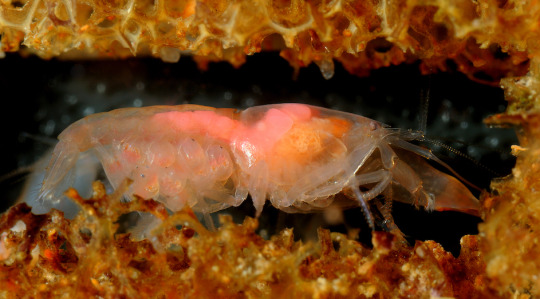
(Image: a eusocial pistol shrimp queen with eggs. Her body is translucent and multiple eggs are attached to her abdomen. The eggs look like translucent balls. The is inside of an orange sponge. End ID)
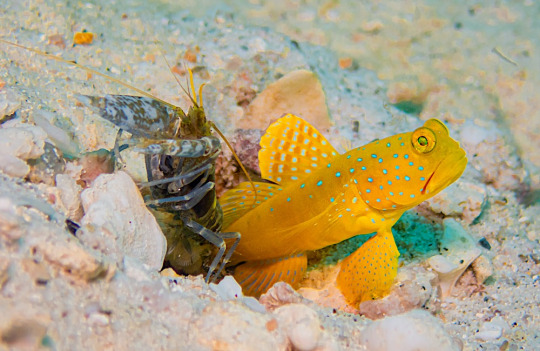
(Image: a pistol shrimp and goby emerging from a burrow in the sand. The shrimp is a mottled green and white. The body is a bright yellow fish covered with blue spots. End ID)
Pistol shrimp are a major source of noise in the places where they live. If you've ever been swimming and can hear repeated cracking noises, that may have been a bunch of pistol shrimp. Some scientists monitor the level of pistol shrimp noises as a method of monitoring the ecosystem. If the noise level drops, that is an indicator that the local ecosystem is suffering. The noise of the shrimps can get so loud that it actually interferes with sonar and forms of underwater communication. During World War II, members of the navy realized that the shrimp disrupted sonar enough to hide submarines, so they started hiding submarines near reefs with lots of the shrimp to keep them from being found by enemy subs. Weirdly not the only small marine animals to mess with submarines. I'll get the the other major one soon. The largest threats to pistol shrimp come from habitat destruction. Some species of pistol shrimp have entered the pet trade. As coral reefs, seagrass beds, and other habitats are destroyed, the shrimp that rely on them will suffer as well.

Yet another time I get to use one of these cards in a post
(Image: the Weird n' Wild Creatures card featuring pistol shrimp. End ID)
231 notes
·
View notes
